Laos Itinerary – Best Places to Visit in Laos for 10 Days
Laos packs a lotta punch for a landlocked country that is often overlooked in favour of its more famous neighbours like Thailand and Vietnam. Other than beaches (duh!), Laos has all the ingredients for a perfect South East Asia escape – quaint towns, beautiful landscapes, wild jungle, adventure activities, fascinating history, friendly locals, good food and of course a cold Beerlao or ten. Phew! Read this post to discover the best places to visit in Laos and how to incorporate them into an unforgettable Laos itinerary.
Why Visit Laos?
Laos is a landlocked country, bordered by Vietnam, Myanmar, Cambodia, Thailand and China. But don’t go discounting Laos just because you’re dreaming of tropical Southeast Asian beaches.
Nope, I’ve been to every country in Southeast Asia bar two (Brunei and Timor-Leste), and it’s a close tie between Laos and Vietnam for my favorite country in Southeast Asia. Got your attention now? I was suprised too, but let me list thy reasons I love Laos.
Reason One – Fewer Crowds: Laos is wilder and more off the beaten track than Thailand and much of Southeast Asia, but is still accessible and tourist friendly. We stuck to fairly touristy towns, and even then it was easy to escape the crowds and find your own piece of paradise only a few kilometres (or less!) from the centre. (I think that’s at least ten reasons in one.)
Reason Two – Natural Paradise: Laos is an outdoor lovers dream. There’s endless outdoorsy things to do in Laos. You’ve got epic waterfalls, hiking, caves, mountains, kayaking, tubing, lagoons, forest, you name it. (Except beaches, don’t name dem.)
Reason Three – Quaint Towns: As well as the great outdoors, Laos boasts one of the best old towns in South East Asia. Luang Prabang is on par with its neighbour Vietnam’s more famous old town of Hoi An.
Reason Four – Somber History: Laos has some interesting, horrific and often overlooked history. Did you know that Laos is the most heavily bombed country in history? Many people don’t realise that Laos was bombed by the US during the Vietnam War in the late 60s and early 70s, and that roughly 80 million unexploded bombs remain today.
OK, this list could go on and on and on, but time is money and all that, so if you’re not convinced yet, keep reading for a little destination inspiration on where to go in Laos.
How Long to Spend in Laos
Most people spend one to two weeks in Laos and focus on the north or south during this time. If you want to visit most of Laos’ highlights and cover both north and south, I recommend 3 to 4 weeks in Laos.
One to Two Weeks in Laos
We had 10 days in Laos and focused on the north. We visited Vientiane (2 nights), Vang Vieng (3 nights) and Luang Prabang (4 nights). If you’re more the outdoor-adventure-type than the old-town-culture-food-type, switch up the number of nights and spend longer in Vang Vieng than Luang Prabang.
You could also squeeze Vientiane, Vang Vieng and Luang Prabang into one week in Laos, or stretch them out into two weeks in Laos for a more relaxed itinerary. In fact, I could happily have spent an entire week in each of Vang Vieng and Luang Prabang alone, both contenders for my favourite town in Southeast Asia!
Three to Four Weeks in Laos
Going to Laos for longer than two weeks? In the north, consider adding Houayxai and Phonsovan. For a cross-country adventure, the highlights in the south are Pakse and 4000 Islands.
Laos Itinerary for 10 Days in Laos
Right, let’s drill down into the best places to visit in Laos and things to do in Laos to build your perfect 10 day Laos itinerary!
Vientiane: 1-2 Days
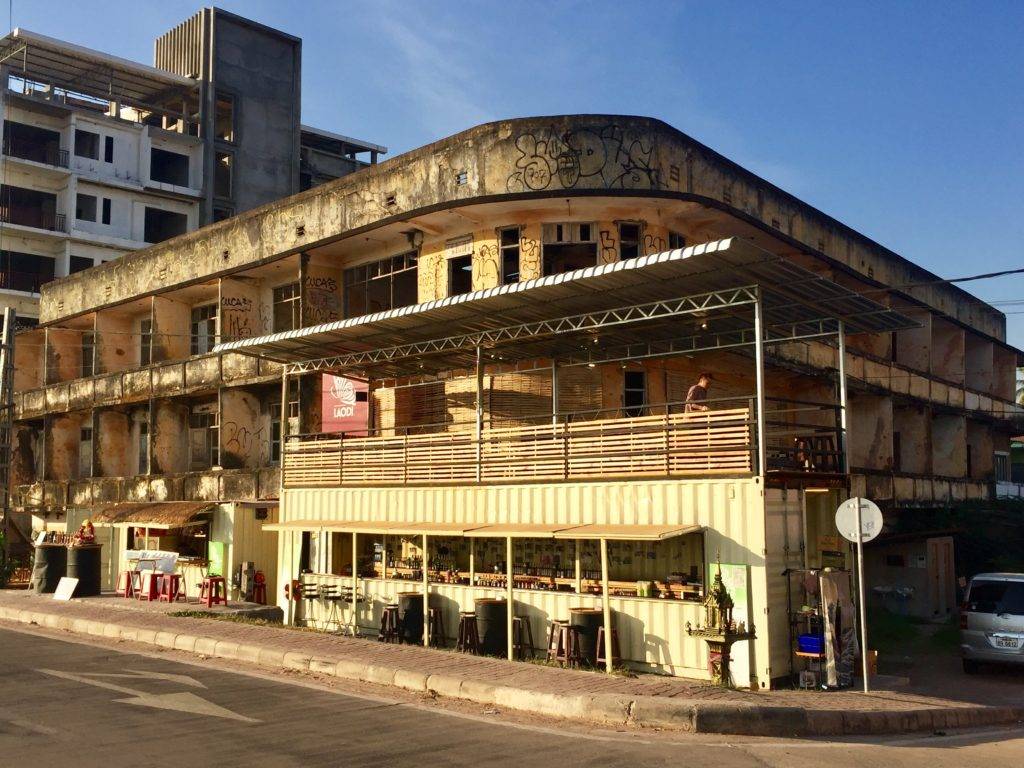
While Vientiane doesn’t have the pull of Luang Prabang or Vang Vieng, there’s definitely enough Vientiane attractions to make a visit worthwhile.
How To Get To Vientiane
Most international flights to Laos land in Vientiane, so it’s often the natural place to start or end your Laos trip.
Once you’re in Southeast Asia, it’s pretty easy to get to Vientiane. There are currently direct flights to Vientiane from Singapore, Thailand (Bangkok), Vietnam (Hanoi) and Malaysia (Kuala Lumpur).
Vientiane Accommodation
Disclaimer: My accommodation recommendations and budget guidelines are for flashpackers, not backpackers! Prices are in USD. I was pretty proud to resist the lure of the luxe in Laos, and stayed in some budget friendly cheaper options. (Well, for me at least. One of my next trips was to the Maldives after all!)
There’s a decent range of well priced hotels in Vientiane. If you stay near the centre, it’s easy to walk or bike to all the main attractions.
$ Budget (<$60): We really only needed somewhere to sleep in Vientiane, so went for a more budget hotel than usual. We stayed at Khampiane Boutique Hotel, which did the trick. Khampiane is basic but comfortable, good value for money and in a central walkable location. I also eyed up Vientiane Golden Sun Hotel and S Park Design Hotel, but preferred Khampiane for its central location.
$$ Mid-Range ($60-100): My picks for a higher end but still good value central hotel in Vientiane are the Crowne Plaza Vientiane or Salana Boutique Hotel.
$$$ Luxury ($100+): Vientiane doesn’t really have any super-luxe hotels, but if you have a bit more cash to splash, try the colonial style Settha Palace Hotel or Ansara Hotel. If you want a peaceful garden location outside the main city area, check out Green Park Boutique Hotel. The pricing for these hotels can drop to mid-range during the off season or if you get a good deal.
Best Things To Do In Vientiane
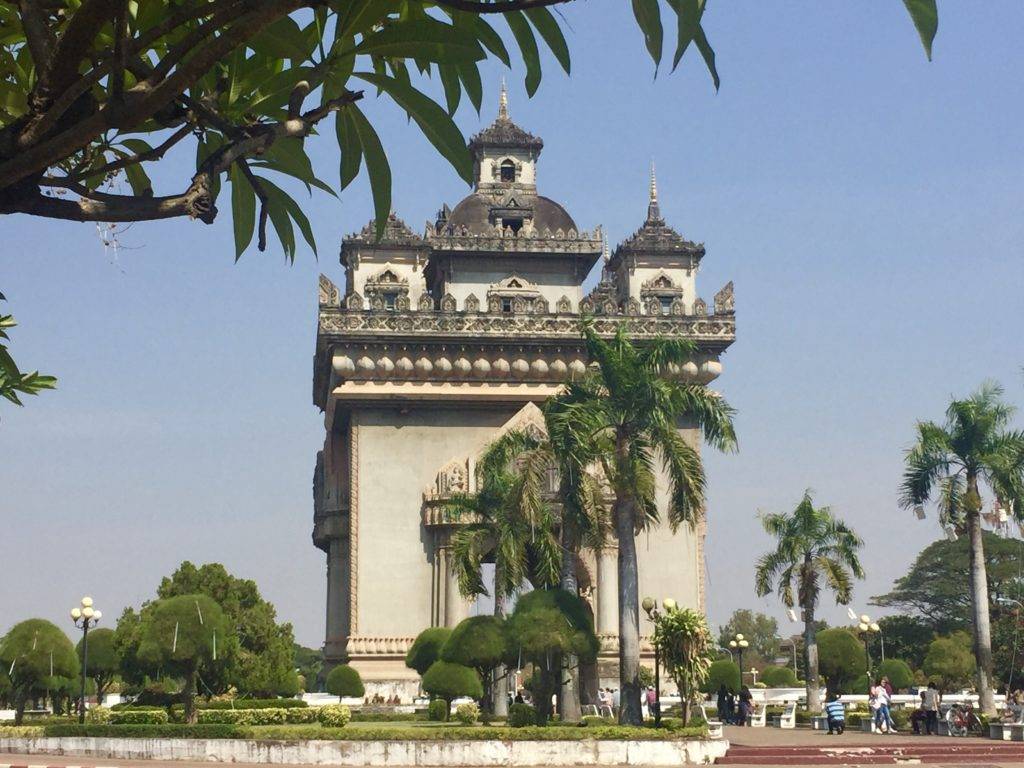
Vientiane’s a fairly compact city, and it’s fast to bike between sites. For us, two nights and one full day was plenty of time to see the sights of Vientiane and even have time to relax. The best Vientiane things to do are:
Temples: There’s Wats galore in Vientiane! You’ll find many small Wats dotted around the central city area. Take a stab at the map, or try the pretty Wat Si Muang and Wat Si Saket. Around five km northeast of the city, you’ll find the Great Sacred Stupa (Pha That Lunag), the largest temple complex in Vientiane. Impressive, but a little over the top for my liking with all that shiny shiny gold hurting the peepers. (In that why-do-people-spend-so-much-money-on-religion-when-there-is-poverty kinda way.)
COPE Visitor Centre: COPE provides prosthetic limbs to victims of the US bombings of Laos during the 1960s and 1970s. Many of the cluster bombs did not detonate and, sadly, continue to maim or kill today, having a devastating impact on the Laotian community. The COPE Visitor Centre has exhibits about the bombings, prosthetics, rehabilitation work and ongoing bomb clearance. Harrowing, somber and moving, but also the most interesting part of our time in Vientiane.
Patuxai: Patuxai (photo above) is a grand war monument in the centre of Vientiane shaped like a gate or archway. Not quite sure it lives up to the title of the ‘Arc de Triomphe’ of Laos (manage expectations accordingly!), but it is worth a quick squiz inside and out. Walk around the surrounding park, check out the ornate detailing inside and then (for a small fee) climb the seven floors of the monument to soak in expansive views of Vientiane.
Cycling: Grab a hire bike in town and you’ll be able to amble around all best things to do in Vientiane in a day or less without rushing. We biked along Rue Setthatirath, stopped at a couple of temples, visited the nearby Cope Visitor Center, then biked a few km to the slightly further afield Great Sacred Stupa, and returned back to the central area via Patuxai. All that and we were back in time for a late lunch and relaxing drink!
Eat + Drink
You won’t go hungry in Vientiane, with plenty of restaurants serving Laotian and international food, and bars filling the town and lining the river front. My fav Vientiane restaurants were:
Noy’s Fruit Heaven: The breakfast at our hotel was pretty average, so I was happy to find Noy’s Fruit Heaven just a few doors along from Khampiane Boutique Hotel. If you don’t like a heavy breakfast, grab a healthy smoothie to start your day.
Lao Kitchen: Lao Kitchen serves traditional and tasty local food for lunch and dinner, and is centrally located.
Riverfront Bars: In the evenings, we walked along the river front for a drink and meal. For a sundowner, we loved Highland Bar (which I think has since closed) or Moon the Night Restaurant. Best for those who like walking, as these are 1-2km from the main drag.
Vang Vieng – 3-4 Days
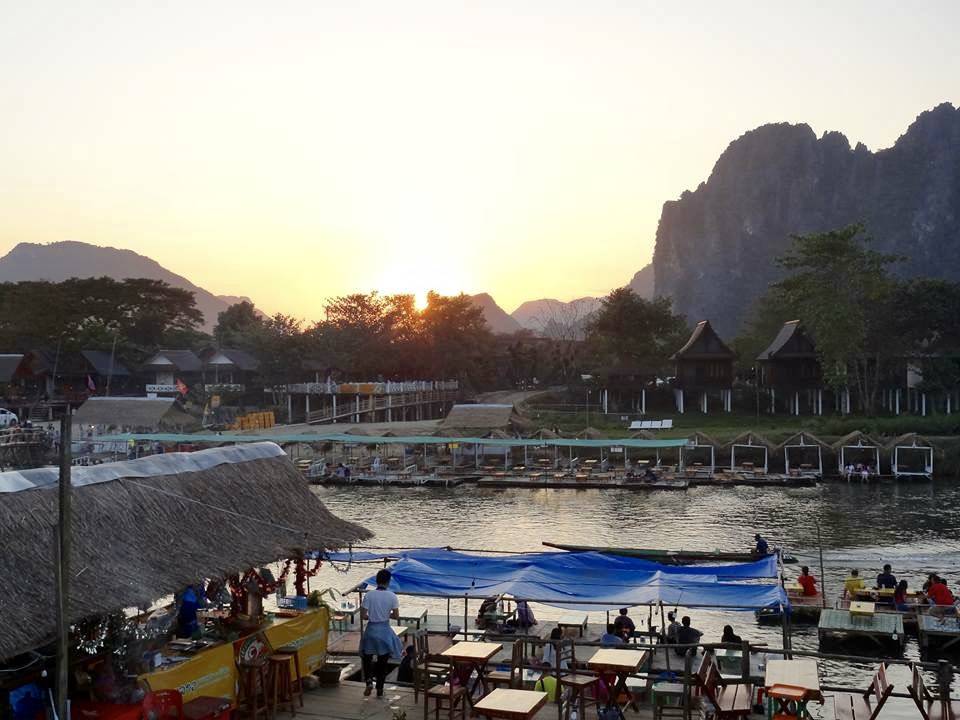
Vang Vieng is the outdoors and adventure capital of Laos. I’m not into adventure sports in the slightest, but absolutely loved the landscapes of Vang Vieng and hiking, biking, caving and swimming my way through the tranquil countryside.
While Vang Vieng has plenty of bars lining the riverside, it now has a more laidback vibe than the party culture it was once known for, after the government cleared up the raucous (and often dangerous) tubing bars.
How to Get to Vang Vieng
Sadly, there’s no airport at Vang Vieng. Vang Vieng is in between Vientiane and Luang Prabang, and is usually reached in a shared or private van from either place.
From Vientiane: The drive from Vientiane to Vang Vieng is roughly 150km and 4 hours. We took a private van organised by our hotel, which was a comfortable and easy drive, albeit a little slow in parts due to the windy roads.
From Luang Prabang: See Luang Prabang below for details of the transfer between Vang Vieng and Luang Prabang. (Warning: Not my most glamorous travel moment.)
Vang Vieng Accommodation
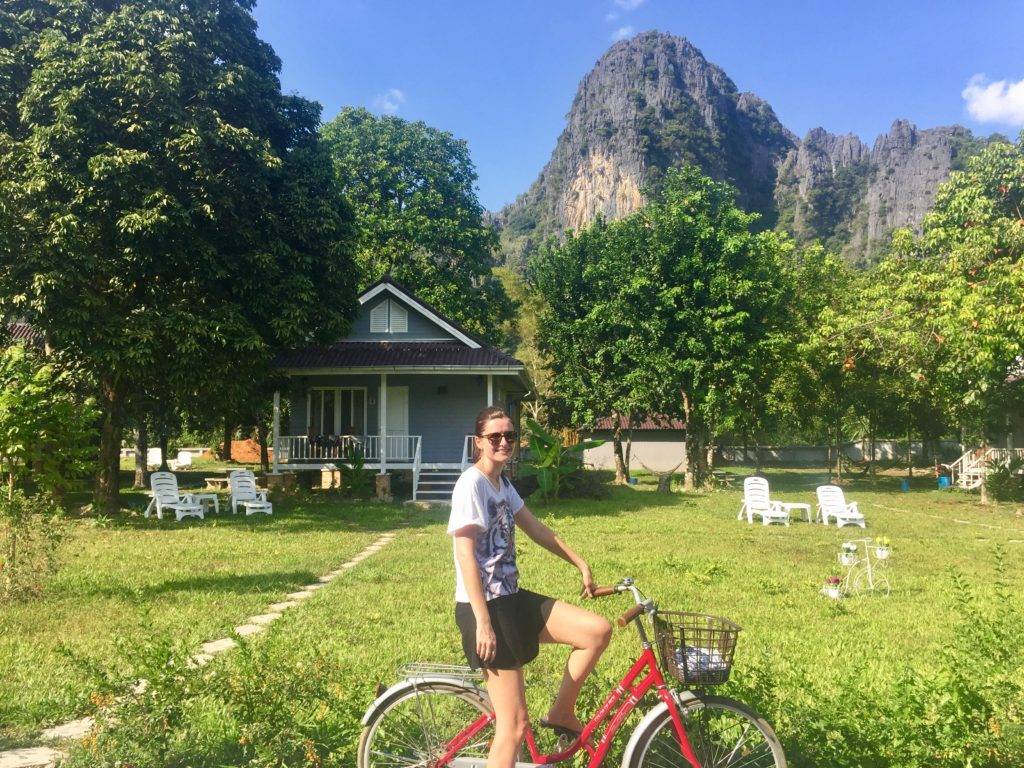
Vang Vieng has great accommodation options, from boutique hotels to homestays, and is very good value for money. I found Vang Vieng to be cheaper than Vientiane or Luang Prabang for comparable quality.
Town vs. countryside: First decide whether you want to stay in town or in the surrounding countryside. The town is set on a pretty river and is convenient for tours, food and nightlife, but can be a little busy and noisy. The countryside is quiet, pretty and one of the main draw cards of Vang Vieng, but has limited food options and requires a short bike, walk or ride to town. We opted for the countryside a couple of km from town, as the region’s natural beauty was our main reason for visiting Vang Vieng.
$ Budget (>$25): My Vang Vieng budget accommodation picks would have been Vang Vieng Boutique Hotel or Laos Haven Hotel, which were both well reviewed and really good value. Alternatively, Maylyn Guest House is an absolute bargain, with rooms from as little as $12.
$$ Mid-Range ($25-60): My heart was set on Bearlin Bungalows from the moment I saw photos of the cute cottages and dramatic mountain backdrop (see photo above). We absolutely loved our stay at Bearlin Bungalows, and thought it was really good value. Bearlin Bungalows is a couple of km outside central Vang Vieng in a quite countryside location, and is only a short bike ride to some of the best caves and swimming holes. There’s a small restaurant on site, and bikes (albeit slow ones!) for getting around. My second pick for a mid-range Vang Vieng hotel would be Green View Resort.
$$$ Luxury ($60+): If Bearlin Bungalows hadn’t been so gosh darn cute, I would have booked Riverside Boutique Resort. Riverside Boutique is a higher end resort, with a central location and excellent restaurant. Alternatively, check out Amari Vang Vieng. Luxury hotels in Vang Vieng come a bit cheaper than elsewhere, but also adjust your standards accordingly!
Best Things To Do In Vang Vieng
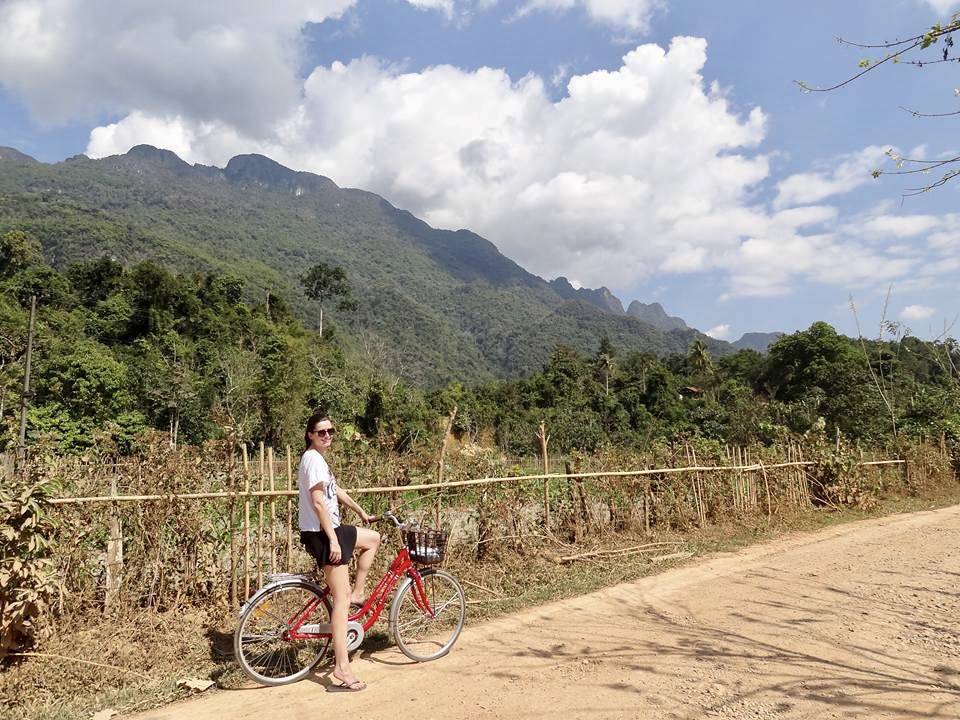
Vang Vieng is all about the great outdoors! There’s no need to plan much in advance, as it’s easy to suss out the lay of the land and get around once you’re there. Here’s all the best things to do in Vang Vieng:
Biking: We grabbed a bike from our accommodation and spent a couple of days cycling around the countryside without much of a plan, stopping in at caves, lagoons and hikes that are well sign posted along the way. We started from Bearlin Bungalows, headed further west away from the main town, and took a couple of the side roads and loop tracks, getting suitably lost once or twice along the way. You’ll find many of the best Vang Vieng things to do along this stretch, including caves, lagoons and hikes. The biking was a little hard going, as the roads were bumpy and our bikes we’re pretty paru (for the non-Kiwis, that’s Maori slang for bit shit). Half the fun though huh?! (She says, with the benefit of hindsight.)
Caves: There’s caves galore around Vang Vieng, of varying styles and difficulties. Some are way impressive, some are less impressive, and some are downright scary (take a torch!). We stuck to caves that we could bike to and explore alone, including popular Tham Phu Kham Cave (home to the Blue Lagoon) and some smaller random caves that we passed along the way on our bikes. One popular cave that we didn’t visit is Tham Nam (Water Cave) around 15km north of Vang Vieng, where you can tube through the cave.
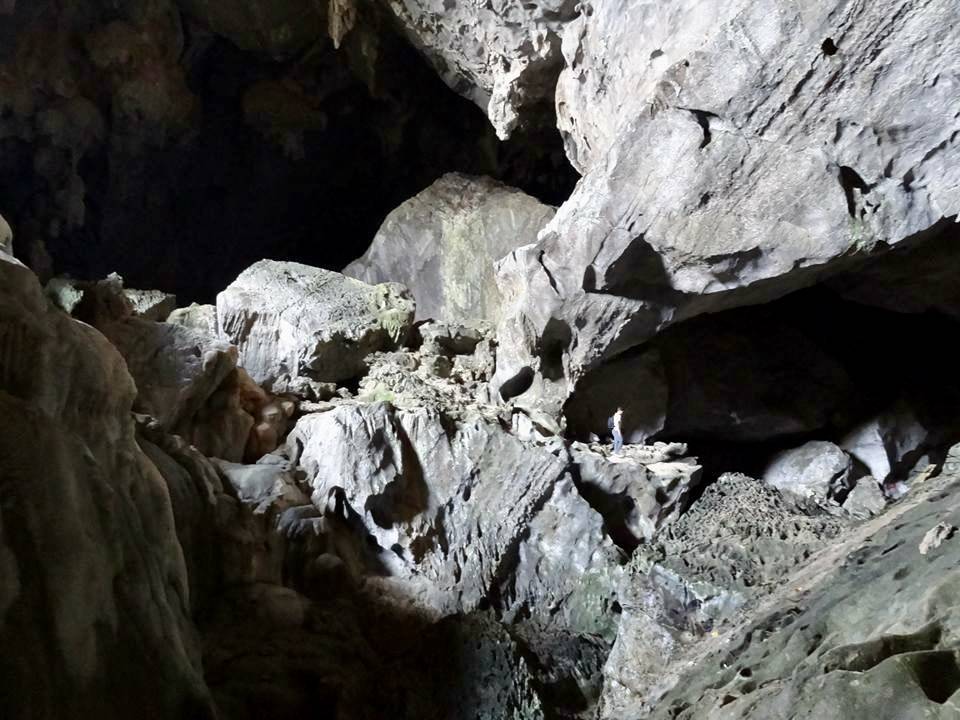
Small small person in large large cave
Blue Lagoon Vang Vieng: On the road west from town, the best Vang Vieng lagoons to visit are Blue Lagoon and Blue Lagoon 3. Blue Lagoon is closer to town and also has a cave (Tham Phu Kham Cave), but Blue Lagoon 3 is much more tranquil with fewer crowds.
View Point Hikes: There’s a few good short hikes to view points around Vang Vieng. Head west out of town past Bearlin Bungalows, and you’ll find Pha Ngern View Point (around 2km past Bearlin Bungalows) and Nam Xay View Point (around 5km past Bearlin Bungalows). Bring plenty of water and wear proper walking shoes, as both hikes are short and steep with rocky trails. The Pha Ngern Hike takes roughly 40-50 minutes, and the Nam Xay Hike takes around 20-30 minutes. Both hikes have sweeping views over the Vang Vieng countryside.
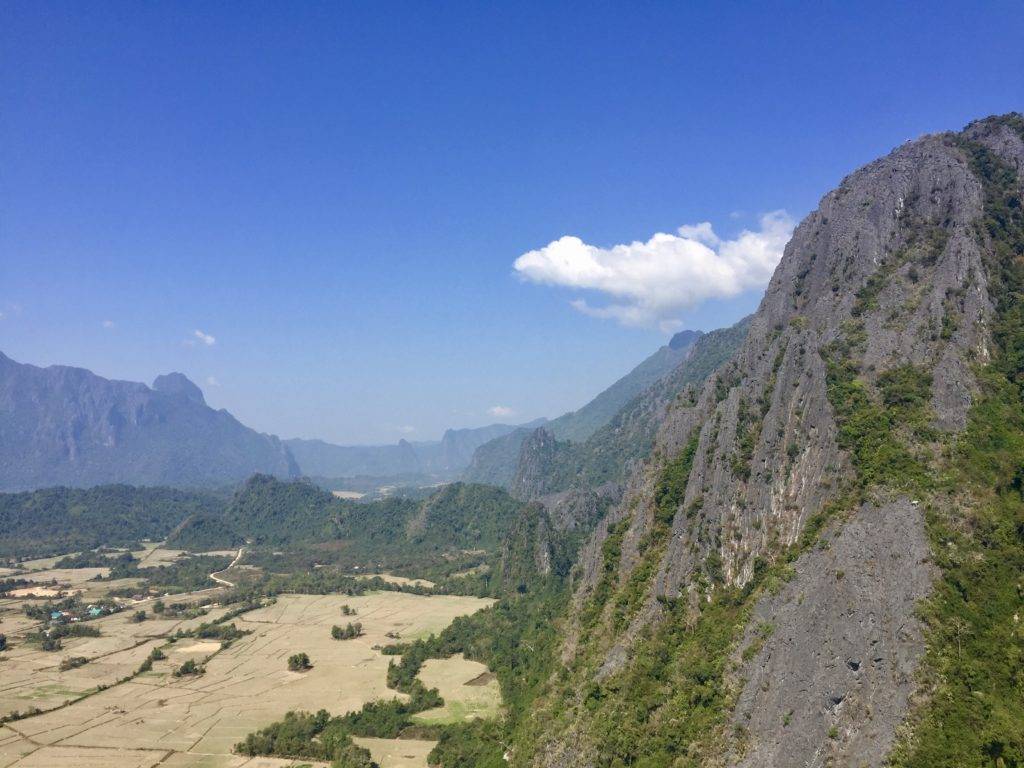
Vang Vieng Tubing: Despite the government crackdown on Vang Vieng river tubing and riverside bars, you can still hire a rubber tube and float your way down the river. I enjoyed river tubing in Vang Vieng much more than I thought I would, probably for the very fact that it’s no longer a massive party of 20-something backpackers risking life and limb by mixing booze, strong currents and flying foxes. There’s still a couple of bars in the first half hour of the tubing, so stock up there (or BYO) if you want to drink your way down the river. It takes a couple of hour to float down the river back to town, give or take depending on water levels and currents. Take a dry bag for your belongings and a rash shirt if you get chilly.
Vang Vieng Kayaking: If tubing’s not your thing, you can also kayak down the river. When we went tubing, there were tonnes of tourists out kayaking who had possibly never been in a kayak in their lives … with ensuing chaos and collisions on the water!
Eat + Drink
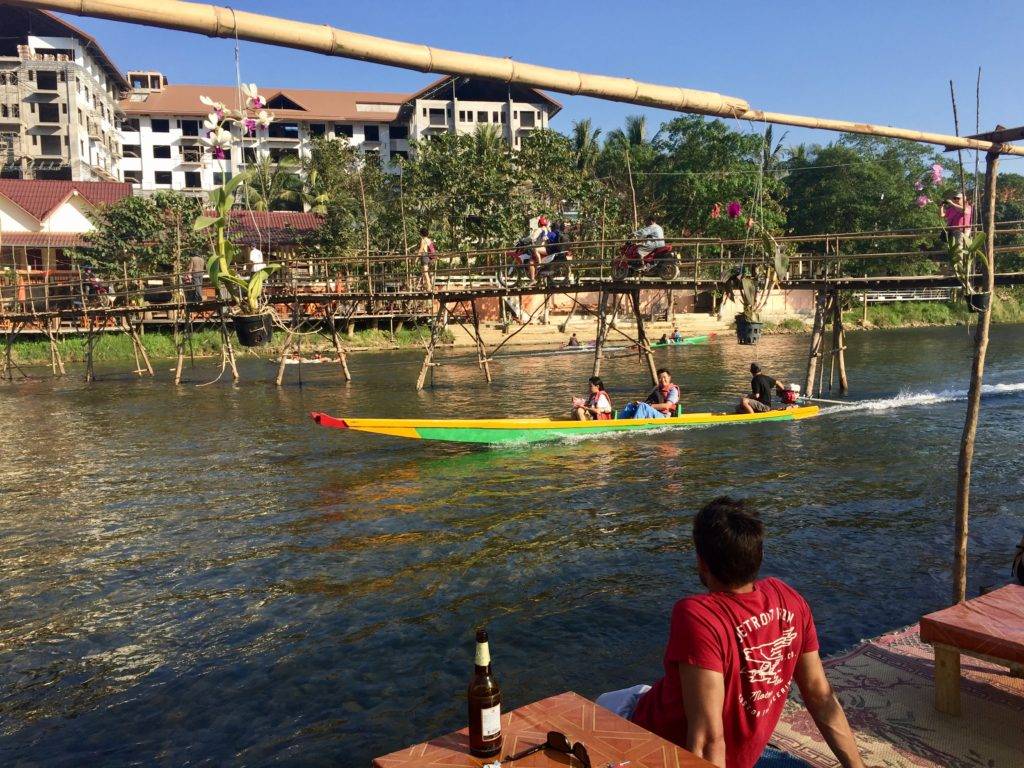
Most of the restaurants in Vang Vieng congregate around the main town area and the riverfront. There’s also some great little local joints dotted around the countryside. We didn’t find any spectacular food, but there were plenty of good restaurants and bars that were perfect for a cold Beerlao and some basic rice, veges and fish.
River Front Bars: I’m a sucker for a scenic view and cold bevvie, so we had many a drink along the riverside restaurants. Try Vanpersay Restaurant or The Elephant Crossing Restaurant & Bar along the river front. While the food’s nothing to write home about, these spots have great views and are perfect for nursing a cold Beerlao while the sun goes down.
The other side of the river (west) is also dotted with local bars where you can relax in little wooden booths with cushions on the river edge. Great for an afternoon of drinking, reading and chilling, but eat at your own risk: quite possibility the spiciest food I have ever eaten!
Countryside Local Eats: In the countryside to the west of the river, there’s a few small local restaurants serving basic but tasty food and cold drinks. Bearlin Bungalows and Lao Valhalla both have good offerings.
Luang Prabang – 4-5 Days
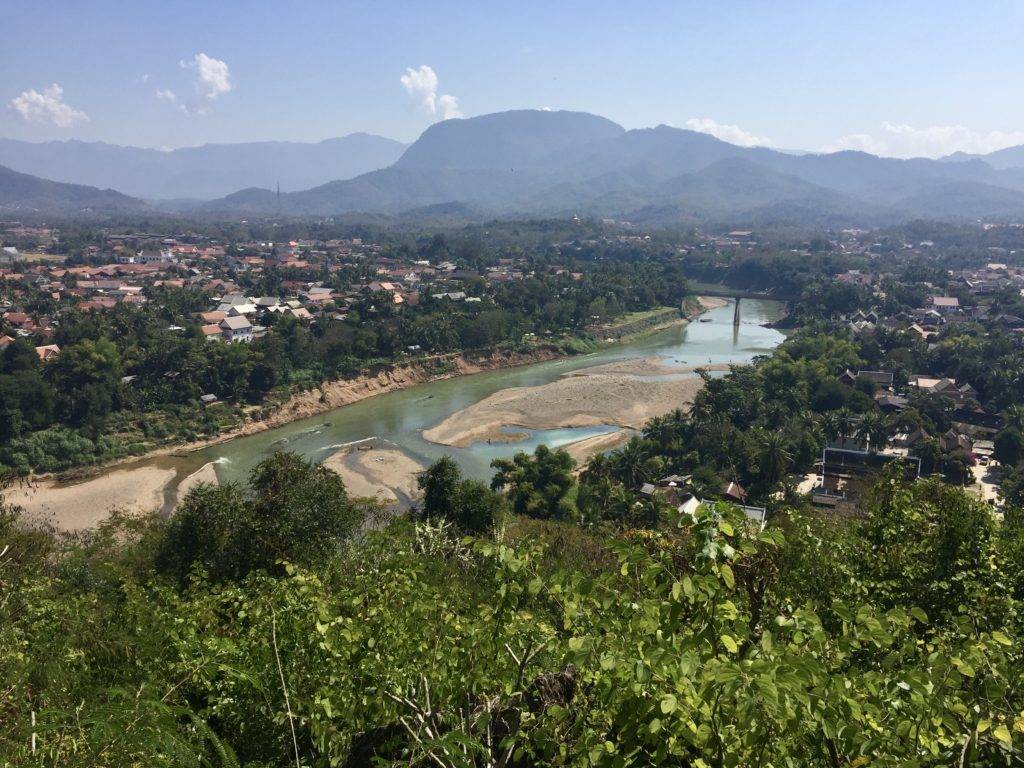
Views of Luang Prabang from Mount Phousi
Luang Prabang is the culture capital of Laos, with a picturesque French colonial old town, intricate temples, foodie culture and beautiful surrounding jungle.
How To Get To Luang Prabang
Luang Prabang has an airport with flights to and from international destinations including Singapore and Bangkok and domestic destinations including Vientiane.
If you’re arriving in Luang Prabang from Vang Vieng, it’s unfortunately a rather long and windy (albeit pretty) overland trip. While the road is only 185km, the drive takes anywhere between 5-8 hours, depending on your transportation. After forking out for a private van transfer from Vientiane to Vang Vieng, we decided to save some pennies on the next leg with a group van transfer. How different could it be?!
For my savings, I was expecting maybe a slightly older model van and seating at full capacity. Ahhm, I was just a little bit wrong. Names can be deceiving, and our ‘luxury’ VIP mini van was a euphamism if I ever did hear one. Expect a puttery old clanger, regular stops at random locales to pick up even more guests, a VERY tight squeeze, and questionable driving ability.
Check out our ride below. Yup, just when you thought the van was full, those are pull down chairs in the aisle! (Reminder to self: private transfers are usually worth the money.) The not-so-glam side of travelling. On the plus side, the scenery was pretty spectacular, and it’s an experience we’ll relive for many years to come.
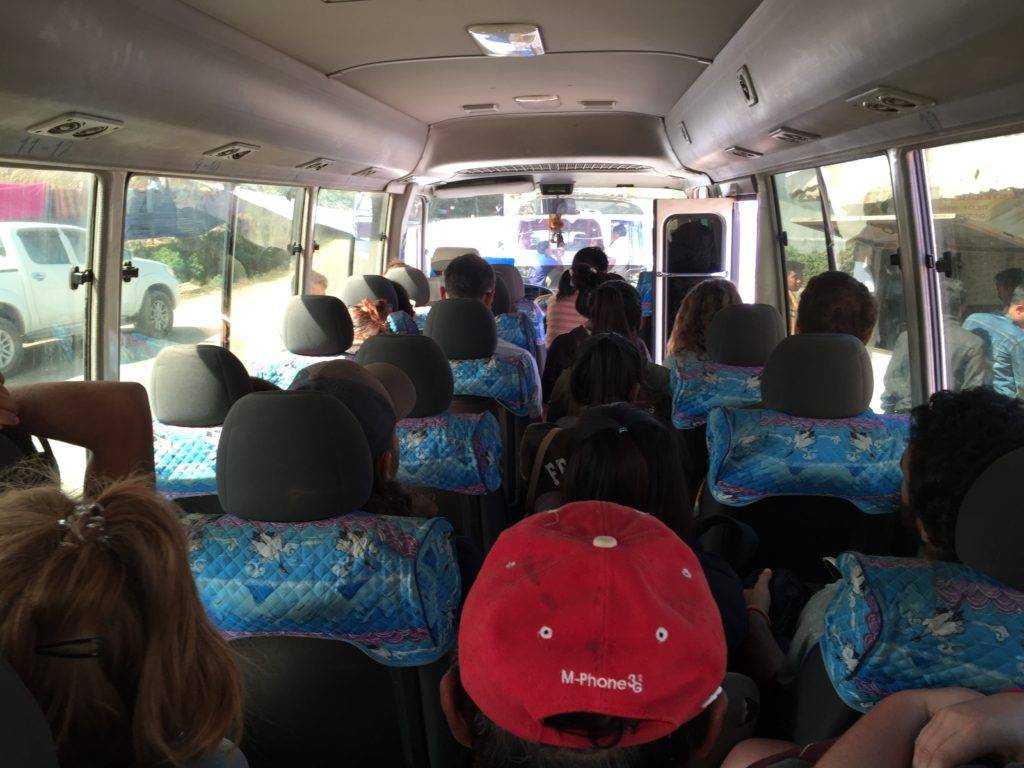
Luxury mini-van: you are duly warned
Tips: Get on the van at the first pick up spot in central Vang Vieng to get a reasonable seat and, if you’re lucky, a seatbelt. Take water and snacks for survival. Think character building thoughts.
Luang Prabang Accommodation
Luang Prabang has the biggest range of accommmodation in Laos, with plenty of choices in the Old Quarter, along the river, and on the outskirts of the city. Expect to pay more in Luang Prabang than elsewhere in Laos.
I chose Le Bel Air Boutique Resort, just across the river from the Old Town. While our hotel was lovely and tranquil, next time I’d stay in the vibrant Old Quarter as I loved it SO much and we spent most of our time there. Plus my absolute favourite style of accommodation is colonial boutique, and Luang Prabang has that in droves! My choices of hotels in Luang Prabang for next time are:
$ Budget (<$60): There’s fewer really good cheap options in Luang Prabang. My top budget(ish) choices in Luang Prabang are Villa Ban Lakkham, Phone Praseuth Guesthouse or Saynamkhan River View.
$$ Mid-Range ($60-$150): There’s some pretty good midrange options in Luang Prabang. In the Old Quarter, I’d go for Lotus Villa Boutique Hotel or The Aspara. Just across the river, check out My Dream Boutique Resort.
$$$ Luxury ($150+): Luang Prabang is the one place in Laos that has true luxury hotels. As you might expect, luxury here costs a lot more (and is of higher standard) than luxury in Vientiane or Vang Vieng. I’m a sucker for luxe boutique hotels, and am little disappointed that I didn’t splash out in Luang Prabang. (Oh well, all the more reason to return!) In the Old Quarter, I was eyeing up The Belle Rive Boutique Hotel or Hotel 3 Nagas. They look so gorgeous! For peaceful luxury just outside the old town, check out The Luang Say Residence or Satri House.
Best Things To Do In Luang Prabang
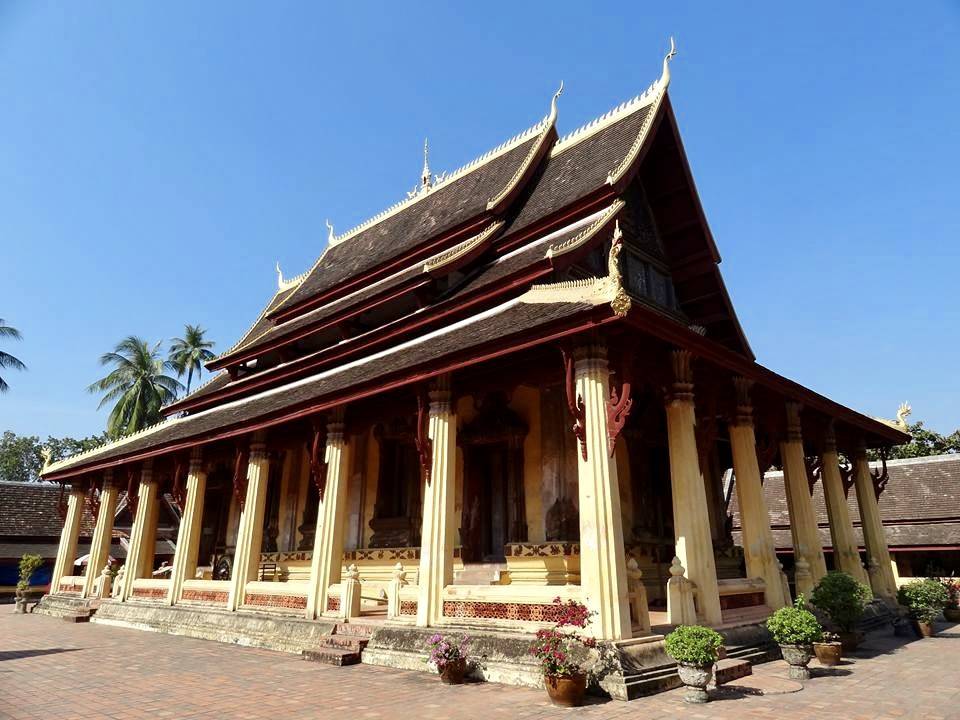
Good news! There’s stacks of fun things to do in Luang Prabang to keep you busy for pretty much as long as you want to stay for. The best Luang Prabang attractions are:
Old Quarter: Luang Prabang’s Old Quarter is the absolute star of the show. We spent most of our days meandering somewhat aimlessly around the historic Old Quarter, a delightful French colonial old town and UNESCO World Heritage Site to boot. It’s filled with colorful buildings, temples and great roadside bars to watch the world go by.
Temples: You don’t have to look far to find ornate Buddhist temples, known as wats, in Luang Prabang. We were a bit templed out from the rest of our travels in South East Asia, so stuck to admiring the wats from the outside. If you’re keen on exploring a few wats, don’t miss the best temples in Luang Prabang.
Mount Phousi: In the Old Quarter, take a short walk up Mount Phousi hill for epic views over the Old Quarter, Mekong River and surrounding mountains. The walk is steep but short, and is doable for anyone with a reasonable level of fitness and no mobility issues (due to the number of stairs). The most popular time to visit Mount Phousi is sunrise or sunset.
Kuang Si Falls: Kuang Si Waterfalls is probably second to the Old Quarter as the most popular tourist attraction in Luang Prabang. Don’t let its popularity put you off, as the cascading waterfalls are truly beautiful, and it’s not as busy as comparable sites in other countries. Kuang Si is also home to a Bear Rescue Centre, with black asiatic bears rescued from pretty awful circumstances.
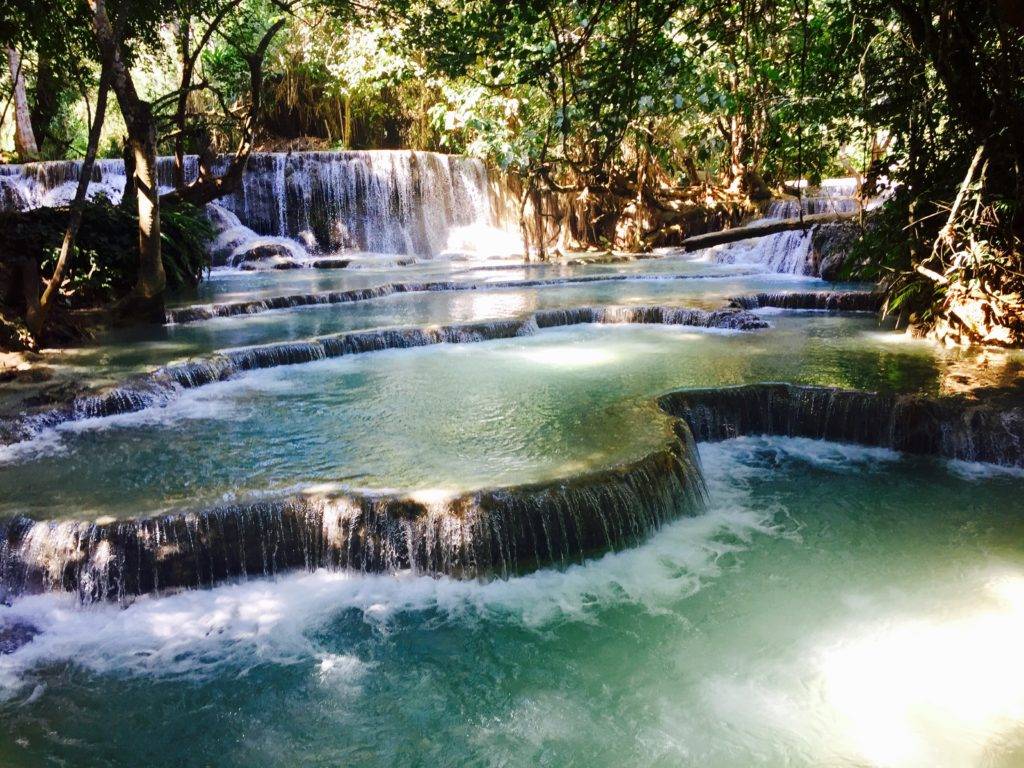
Kuang Si Falls is around 30km south-west of Luang Prabang, so most (sensible) people take a motorbike, tuk tuk or shared van. Not us though! Nope, bouyed by my recent attempts at cycling around Vang Vieng, I decided to bike the rather challenging hilly route to Kuang Si Waterfall, and take a relaxing return boat down the river. I almost didn’t make it and had to push my bike the last kilometre. While I was hating on life at the time, it was pretty satisfying to reach the falls and take a refreshing dip. If you’re a little crazy up for a challenge, we really enjoyed our Kuang Si bike tour with Tiger Trails.
Other Waterfalls: There’s several other waterfalls around Luang Prabang, including Tad Sae Waterfalls. I needed at least a couple of days to recover after biking to Kuang Si, so we gave Tad Sae a miss.
Bamboo Bridges: During the dry season (around November to May), take the bamboo bridge to cross the Nam Khan River. The bridge is an attraction in itself, but you can also reward yourself with a cold bevvie at Dyen Sabi on the other side of the bridge (see Eat + Drink below). The bridge is rebuilt each year after being washed away during the wet season.
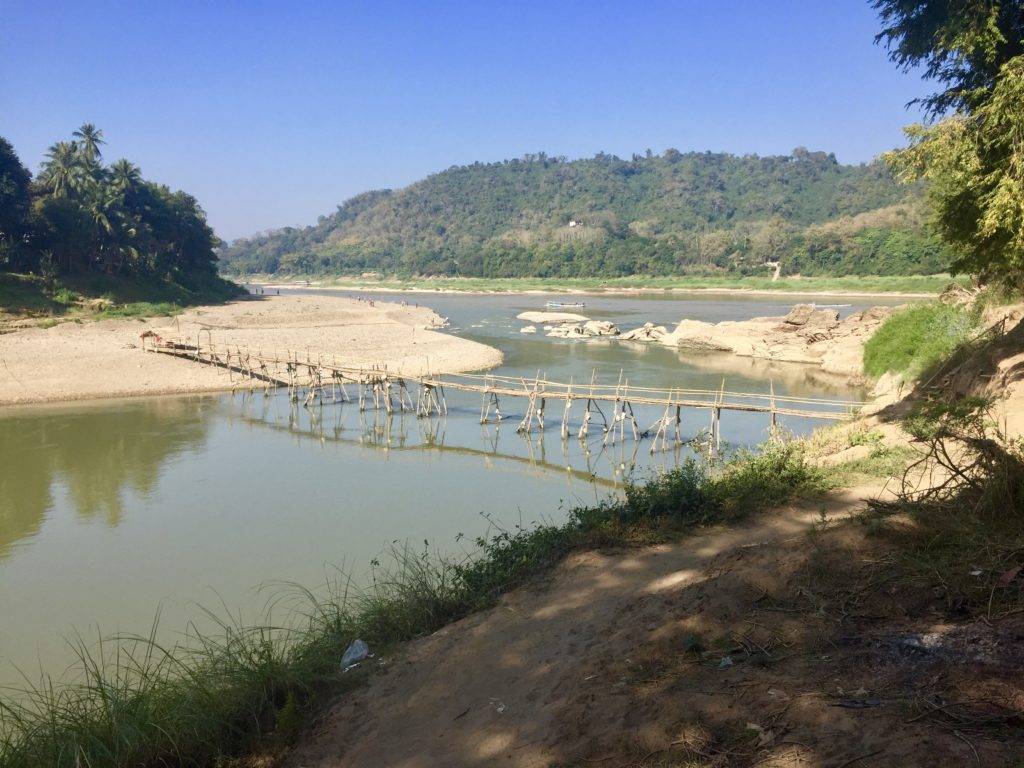
River Cruise: We took a super chilled river cruise back from Kuang Si Falls to Luang Prabang (note: needs to be organised in advance). Alternatively, pop down to the river front in the Old Quarter and take a sunset cruise or a boat ride to Pak Ou Caves.
Pak Ou Caves: Pak Ou Caves are two caves with mini Buddha figures, around 25km or two hours by boat from Luang Prabang.
Biking: Like most of Laos, Luang Prabang is a great spot for exploring on your wheels. As well as the Old Quarter, we loved cycling around the residential area on the outskirts of the old town and the east side of Nam Khan River.
Eat + Drink
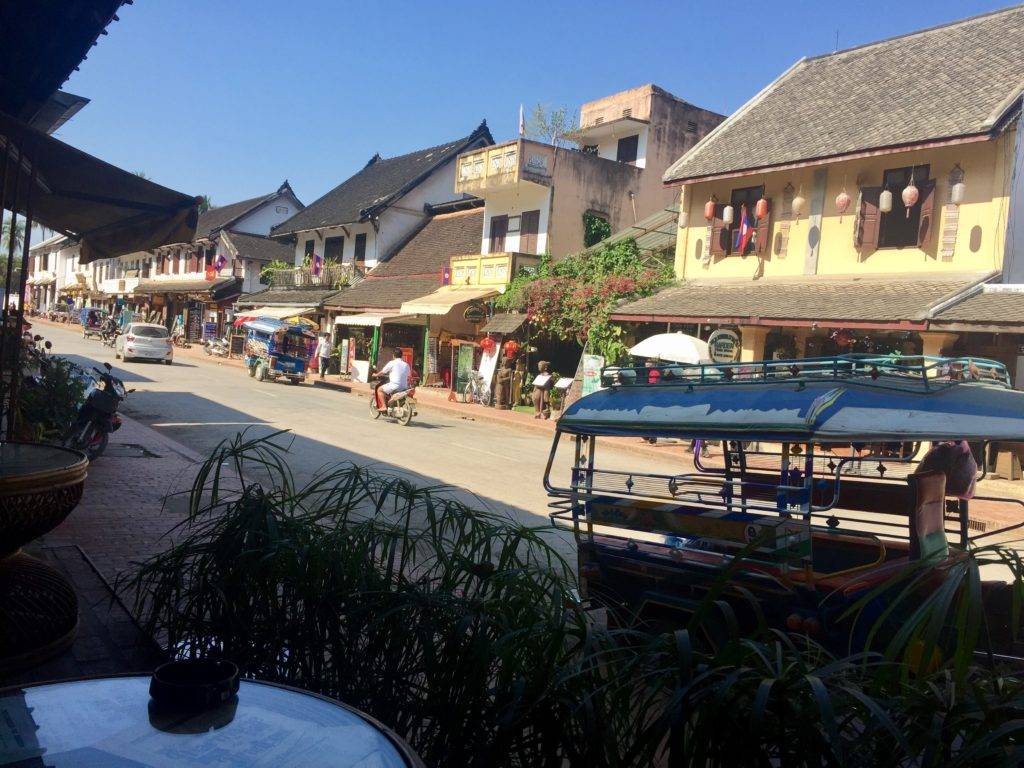
Luang Prabang has hands down the best food we had in Laos, and is the only place we really ate out for the experience. You’ll be happy regardless of your tastes, as Luang Prabang has street food, cafes, bars and restaurants, with a mix of Laotian, French and international food.
There’s scores of well reviewed Luang Prabang restaurants on TripAdvisor, or do as we did and wander into whatever takes your fancy. My favs were:
Tamarind: I highly recommend Tamarind if you want to splash out one night on a delicious Laotian degustation dinner. Booking recommended.
Tangor: Tangor is a French bar and restaurant along the main street of Luang Prabang’s Old Quarter. Tangor quickly became our local, and we had a drink (or three) here every day. Great spot for people watching!
Dyen Sabai: I loved Dyen Sabi for a chilled drink and meal with lovely views over the river. You can reach Dyen Sabai by walking acrosss the bamboo bridge.
Other Places to Visit in Laos
Sadly, we only had ten days in Laos so didn’t have time to visit everywhere on my list. For a longer trip, check out the following locations. Houayxai and Phonsovan are in northern Laos so combine well with my itinerary above. Pakse and 4000 islands are the ‘can’t miss’ locations of southern Laos.
Houay Xai
I reluctantly dropped Houayxai from my Laos itinerary due to time constraints. Houayxai borders northern Thailand, so is a popular starting point for travelers entering Laos from Chiang Mai or Chiang Rai.
For me, there’s two pretty good reasons to visit Houay Xai. First, you can take the two day slow boat from Houay Xai to Luang Prabang. I’m not sure if this boat would be all relaxing and romantic, or totally uncomfortable and boring. Not one to risk discomfort, I’d probably opt for the luxury Luang Say Mekong Cruise, where you overnight at the lovely looking Luang Say Lodge (for an equally lovely looking price).
Secondly, I love jungle and wildlife travel experiences, and have heard only good things about the Gibbon Experience in Laos, around 1.5 hours from Houayxai. Here, you stay in treehuts in the forest canopy and zip line around the lodge.
Phonsovan and the Plain of Jars
I also toyed with visiting Phonsovan, where the main attraction is the mysterious Plain of Jars. Yup, this is quite literally, a plain with thousands of stone jars scattered around the valley. Much like Stonehenge, the original purpose of the jars remains a puzzle.
I couldn’t quite decide whether the Plain of Jars would be a fascinating archeological site or whether it was just, well, a plain old plain of jars that I’d be done with in 15 mins. In the end, I decided to give the Plain of Jars a miss due to the long trip. It takes around 8 hours to get to Phonsovan from Vang Vieng or Luang Prabang.
Pakse
Paske is a charming French colonial old town in southern Laos, and is like a min-less-touristy-more-laid-back Luang Prabang. It’s also the gateway to the Champasak Province, where the highlights include jungles, waterfalls and islands.
Si Phan Don – 4000 Islands
Another highlight of the Champasak Province is Si Phan Don, or 4000 Islands, in southern Laos near the Cambodian border. Si Phan Don is a riverine archipelago, or a collection of islands along the Mekong River. Some of the islands are barely bigger than a rock and disappear when the tide rises, while others house entire villages.
Best Time to Visit to Laos + Laos Climate
Finally, it’s always important to know the best time to visit Laos before you plan your trip!
Best Time: The cool dry season from November to February is generally the best time to visit Laos. We travelled to Laos in early February, for warm to hot days and cool(ish) nights (at least by South East Asia standards!).
Rainfall: Like many places in Asia, Laos has a dry season (October to April) and a wet season (May to September). The rainy season is usually limited to a good old afternoon downpour rather than all day torrential rain, but can impact overland travel and infrastructure. August is usually the wettest month.
Temperatures: Laos has a tropical warm climate year round. My kinda weather! Expect temperatures to be hotter and more humid from the end of the dry season to the start of the wet season (March to June). It can also be hazy during this time as farmers burn off crops. The climate also varies throughout the country, with (sometimes surprisingly) cooler temperatures as you head north.
I’m looking forward to planning my next trip to Laos. I hope you love Laos as much as I did!
Note: This page contains affiliate links. That means that if you click a link, I may receive a small commission at no additional cost to you.
Like it? Pin it!
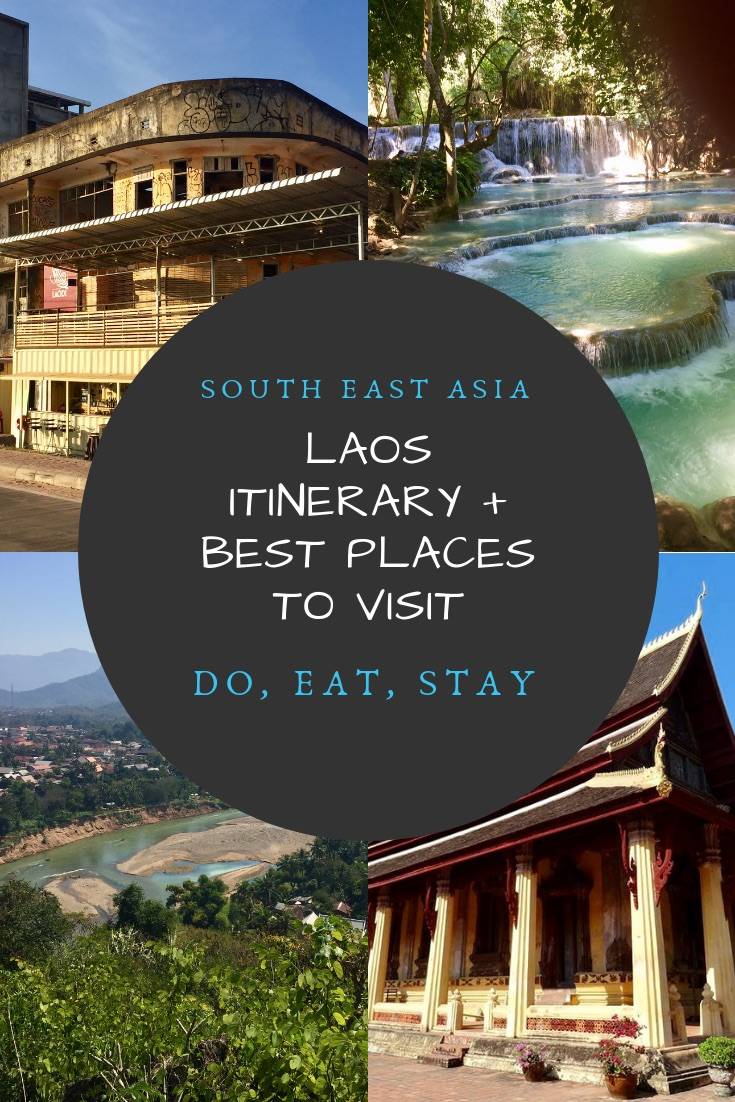
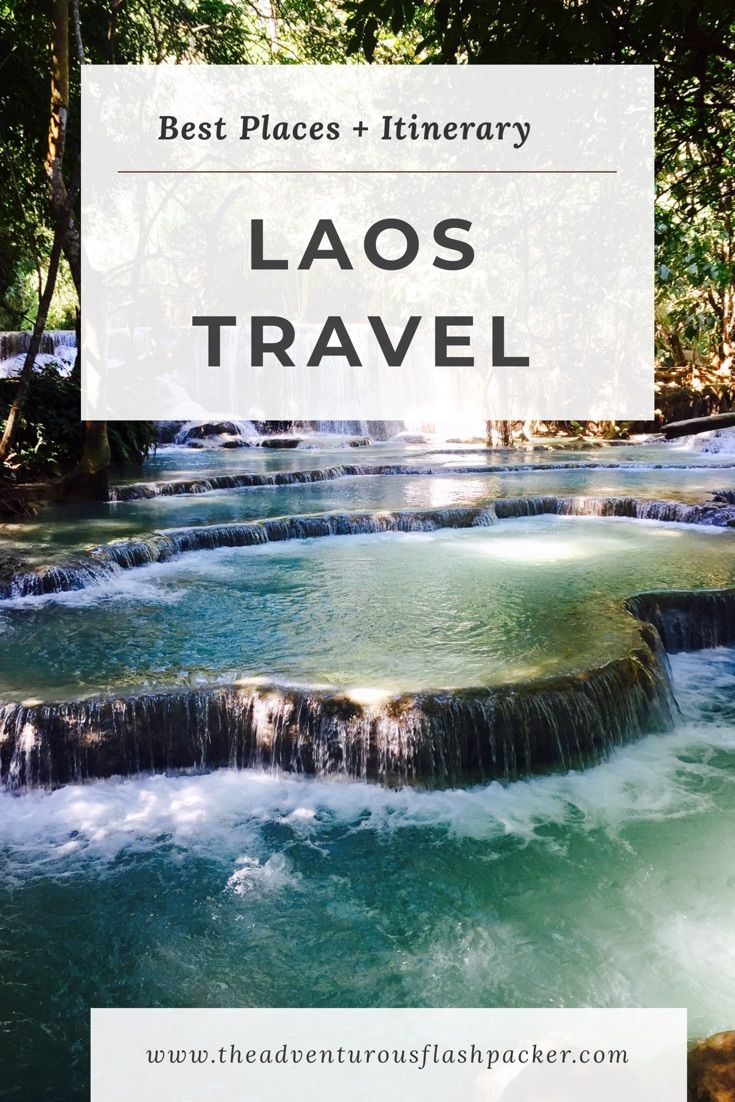
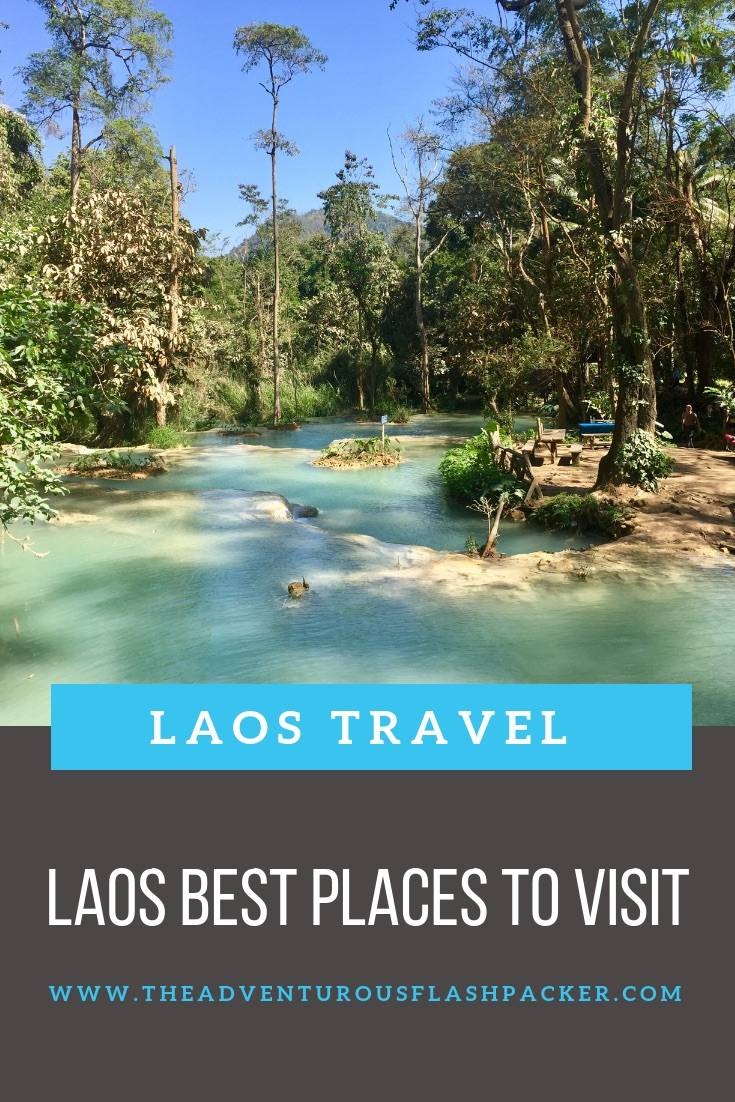
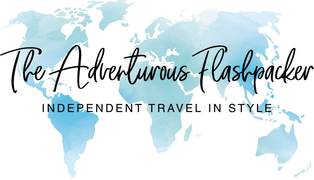
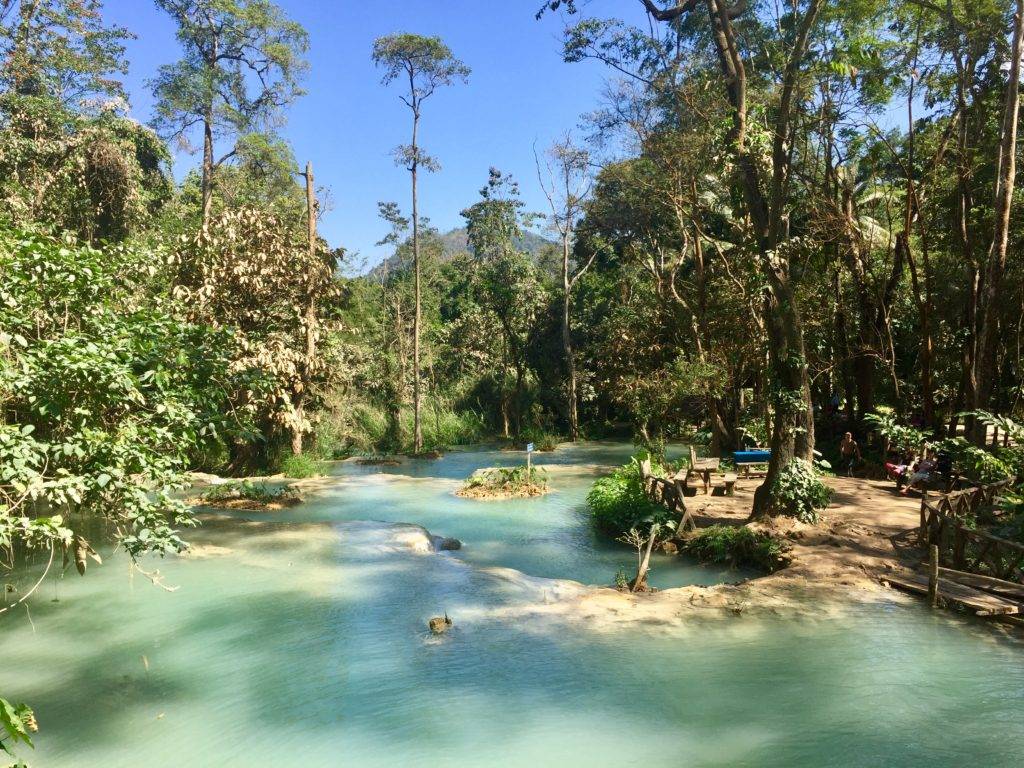
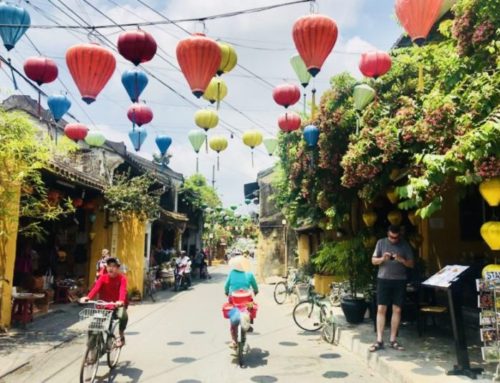
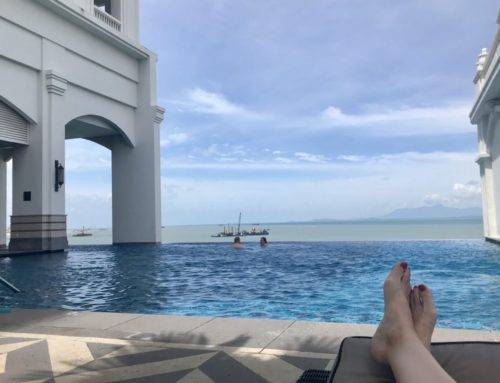
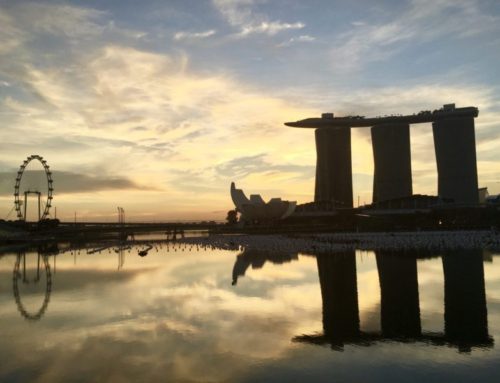
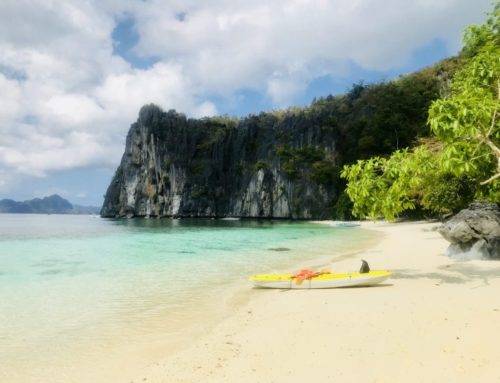
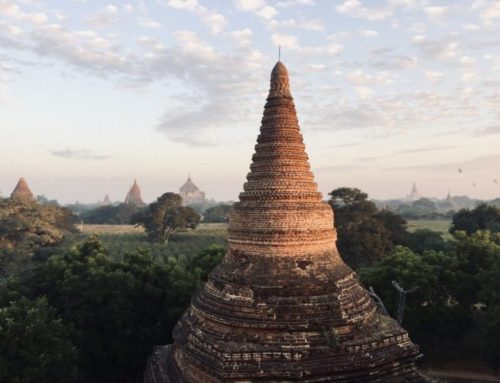
What a thorough guide! I would love to visit Laos and get a bit off the tourist track. I also had no idea that Laos was the most bombed country in the world. So sad.
Thanks Kelly! Laos is a really wonderful country with a tragic history. I’d love to return and get even more off the beaten path next time!
Thanks for sharing! This is a really good overview of the places in Laos to visit and see. Maybe one safety tip we can share is to be wary of boat scams – there are some unscrupulous tour companies or boat captains who will lie to get you to board a more expensive private boat or another variation is to leave you abandoned at a spot 10km from your destination. Of course, that’s a spot where the tuk tuk drivers are waiting at..
Otherwise, enjoy Laos! 🙂
That’s a great Laos travel tip, thanks for adding it! Luckily we didn’t fall prey to any travel scams in Laos.
What a detailed guide to travel in Laos!
Laos is indeed a wonderful country but sadly it is often underrated by its famous neighbors such as Vietnam, Thailand and Malaysia. I love the charm and ancient vibe of the country, especially peaceful and homely atmosphere in Luang Prabang.
I will definitely return to Laos and visit Vang Vieng.
Btw, keep up with your awesome work!
Aw thanks, I totally agree! Laos is one of my fav countries in Southeast Asia and I often recommend it to people. I’m hoping to return to Luang Prabang soon. You should definitely visit Vang Vieng, such a beautiful place!
What a great guide, very thorough and interesting. Hopefully once the borders are open again people will be back to Laos and will pin this for later.